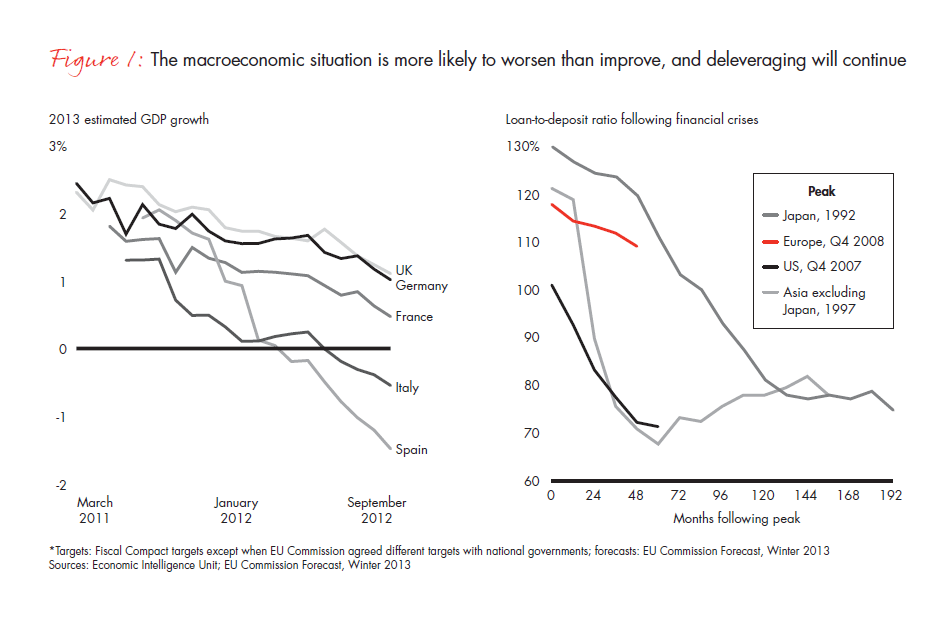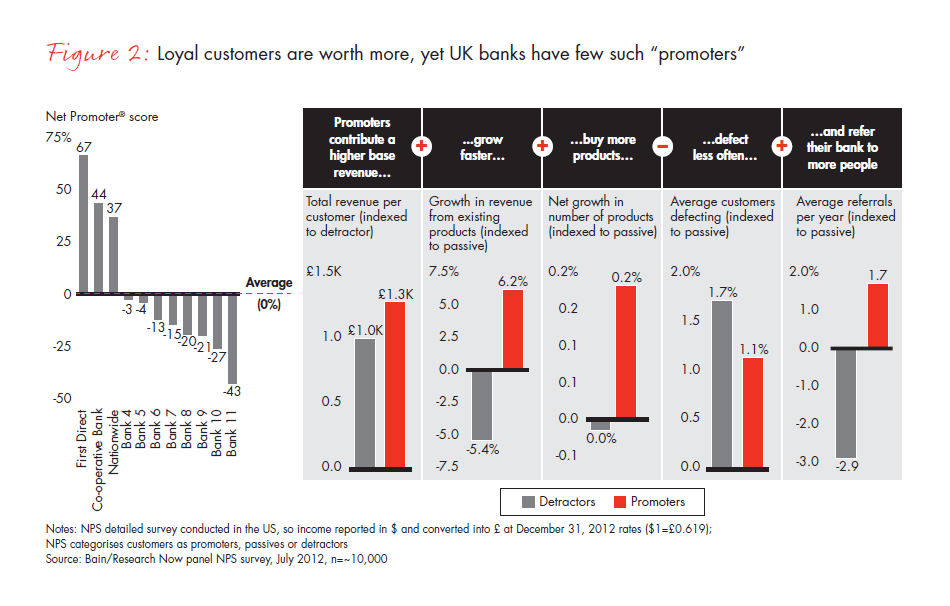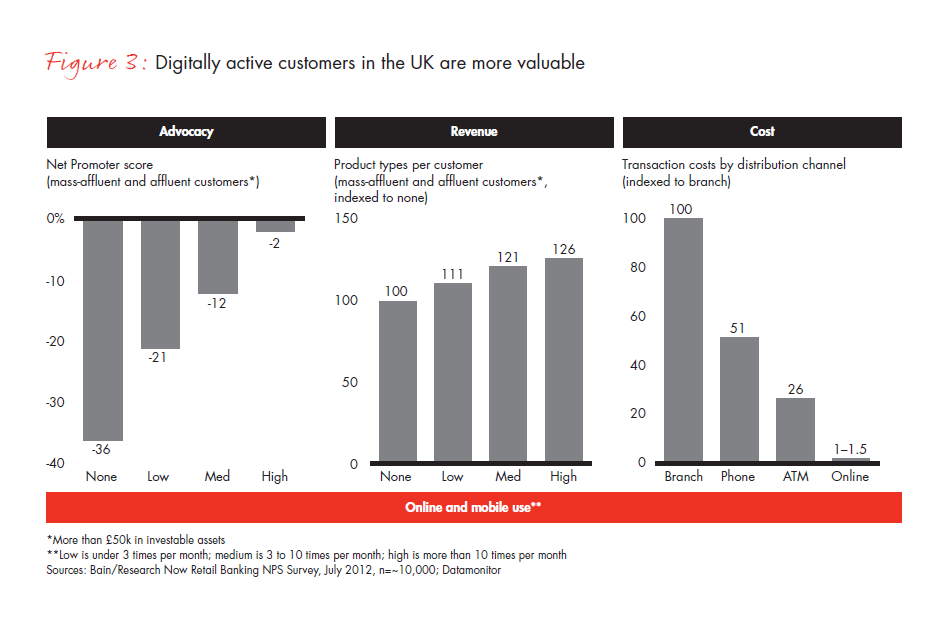Article
For the past five years, UK retail banks have had their heads down in a bunker, fending off fallout from the financial crisis, trying to mitigate the impact of the latest scandal and dealing with the latest government mandate. As such, they’ve barely had a moment to look up and notice how the market has changed in fundamental ways.
Profit pools, for instance, have shifted toward more affluent customer segments and regions. At many banks, the wealthiest 10% of the customer base generates virtually all of the profits.
Given that shift, London and southeast England have become increasingly important battlegrounds, while regions that rely heavily on public-sector employment, such as areas in the north of England, may grow less attractive. Nevertheless, within each region there will be pockets of more attractive customers, so banks do need to take a microview of regional markets.
Both incumbent players, such as HSBC and Barclays, and relatively new players, such as Metro Bank, M&S Bank and Virgin Money, are targeting affluent households. Meanwhile, other new entrants are taking advantage of online tools to reach mass-market customers who want more convenience and transparency. At the same time, they’re also capturing share with more affluent customers who appreciate simplicity and ease of use. Some of the upstarts, such as peer-to-peer money exchange Zopa, position themselves as “anti-bank” innovators. They appeal to customers dissatisfied with banks and who seek a fairer and more digital offering.
These shifts in the competitive field come as the combination of a weak economy and more stringent regulation is squeezing profits and putting more pressure on costs.
Despite recent optimistic economic forecasts, we think it’s more likely that Eurozone growth will be weak over the next five years (see Figure 1). And regulation is intensifying, from Basel III regulations, to the Independent Commission on Banking’s proposed ring-fencing around retail bank operations to separate them from investment banking arms, to potential new rules that would limit cross-subsidised products. The combined impact of new regulations could reduce UK retail banks’ return on equity by seven to 13 points from the 2012 average of 17%.

Forward-thinking banks will come out of the bunker and develop a plan to survive on this new battlefield. They need to take out a substantial amount of cost while at the same time generating higher sales from a loyal customer base—a dual challenge that many banks have struggled with.
Our work with UK and global retail banks suggests that this joint challenge can be addressed by focusing on three interconnected areas: offering simple products with transparent pricing; acting quickly on feedback from customers in order to build loyalty and lift sales; and fully embracing the opportunity provided by digital technologies to lower costs, improve service and support sales.
Offering simple products with transparent pricing
Generally only a few products account for the great majority of profits at a retail bank, yet the long-tail products require expensive systems and processes to maintain, as they often sit on legacy platforms. Large UK banks typically offer between 30 and 40 front-book products and have two to three times that number in their back book. Reducing the range and complexity caused by product proliferation thus lowers costs, including the costs of conduct risk associated with a large product portfolio.
At the same time, product simplification makes choices easier for customers and for frontline sales and service employees. It promotes the growth of digital channels because there are fewer items to migrate to a website or mobile application, and simplicity makes for a better online experience. New players understand that dynamic and tend to have a simplified product range. M&S, for instance, has just one premium current account.
Transparent pricing addresses a different concern, namely the widespread public perception of unfairness—an underlying theme of recent Financial Conduct Authority regulations prohibiting cross-subsidies in fund platform services. High introductory interest rates for newdeposit customers, for example, are viewed as unfairly subsidised by existing depositors, and recently, there have been growing complaints around existing insurance customers being given significantly higher quotes than new customers.
Several retail lenders have benefited from more fair or transparent pricing. In mortgages, Nationwide has gained market share in part through a campaign pledging that a significant proportion of existing mortgage members have access to an interest rate capped at 2% above the Bank of England base rate. In short-term money lending, online provider Wonga charges high fees but still remains successful because of its transparent presentation and simple proposition.
Acting quickly on customer feedback
Banks looking to return to organic growth need to focus on retaining and delighting the most profitable customers. Loyal customers buy more banking products, stay longer, cost less to serve and urge friends to become customers. Gaining share of a customer’s spending is particularly important to a retail bank’s economics (see Figure 2).

While many UK banks talk about improving the customer’s experience, few have managed to do so—and none would be considered loyalty leaders by global standards. Loyalty leaders have built a great experience by developing processes for short-cycle, closed-loop feedback, learning and action. “Closing the loop” involves sharing feedback from a customer, as soon as possible after it is received, with the employees most responsible for creating that customer’s experience. The feedback can then be used to remedy individual problems and systemic issues. It also serves to find out what a bank is doing right—what sorts of experiences are wowing customers and turning them into promoters—so the bank can do more of it.
The trick is to focus on the small set of actions that will yield the greatest improvements. Leading banks identify the highest-value customers and invest differentially in them, rather than taking an overly democratic approach. Metro is expanding in high-end London neighborhoods through features such as extended branch hours and the ability to open a working current account in just 15 minutes.
Embracing the digital opportunity
Digital channels can be a powerful means of building loyalty—when those channels emphasise the right features and transactions, and when they dovetail tightly with phone centers and other ways that banks touch their customers. UK customers increasingly expect to be able to choose the channel most convenient for them, whether digital or physical, and they want all channels to work together harmoniously.
A 2012 survey of UK bank customers by Bain & Company found that digital channels are delighting consumers much more than branch services. People value advanced digital features like remote bill paying, and they also value the convenience of mobile devices for straightforward tasks, such as checking their account balance. Moreover, online customers have proven to be more valuable in their level of loyalty, the revenue they generate and their cost to serve (see Figure 3).

While many UK banks have only recently come to appreciate the level of digital disruption sweeping through their industry, the leaders are already starting to change in three areas.
They integrate distribution channels. A seamless “omnichannel” approach allows the customer to do business with a bank whenever, wherever and however she chooses. But how a bank prices products and services across all its channels needs to be transparent and uniform. Multitier pricing that does not convincingly demonstrate a distinct value proposition risks alienating customers.
They redesign the branch network. Mobile and online channels, if executed well, also can divert volumes from higher-cost brick-and-mortar channels at a fraction of the cost. That’s why Barclays introduced its secure Web chat with advisers.
Some banks are starting to close underperforming branches. More broadly, the network will evolve to a different shape, such as a lighter yet sturdier hub-and-spoke system. Branches are becoming more important as product showrooms and as places where customers seek expert financial advice.
Success with a more economical network will hinge on an investment in hiring, training and developing qualified financial advisers and multitalented customer service representatives. Value-added advice and peerless customer service, not mere convenience, will be the hard currency of the digitally powered bank.
They protect their franchise. Potential rivals can encroach from any direction, whether Internet powerhouses like Google, online payment systems like PayPal or new entrants like Hello Bank, launched by BNP Paribas; each offers some mix of greater speed, convenience and lower cost. With barriers of entry crumbling, leading banks have sharpened their market intelligence to scan for emerging competitive threats.
These banks scrutinise each link of their value chain to assess potential vulnerabilities and erect defences to reinforce their higher-profit-margin businesses and their grip on their most valuable customers. They take measures to know their customers better than any potential rival can. They innovate to increase customer convenience. And they invest in building a stronger brand that earns customer trust and loyalty.
They harness the power of Big Data. Leading banks have started to use their customer data to target specific offers based on customers’ demographic profiles, spending patterns and current product holdings. Large UK retailers have more experience in using customer data this way, so it’s not surprising that Sainsbury’s Bank announced plans to double or triple the number of customers by analysing data it has on customers of Sainsbury’s supermarkets. Some banks also are drawing on customer- spending data to make better credit decisions.
Can the incumbents bounce back?
Focusing on these three interconnected areas will help UK banks to improve the customer’s experience and generate sustainable economics. Simplification makes going digital easier and reduces errors, which improves customer loyalty. And visibly acting on customer feedback leads to greater loyalty and higher spending.
Each move will help to position a bank favourably for the tough economic environment that may persist in the medium term. Outside disruptors have taken advantage of the financial crisis to make inroads in the UK through top service to affluent customers or great convenience to the mass market. With the acceleration of digital technologies throughout all aspects of banking, UK banks have a once-in-a-generation opportunity to do the same.


